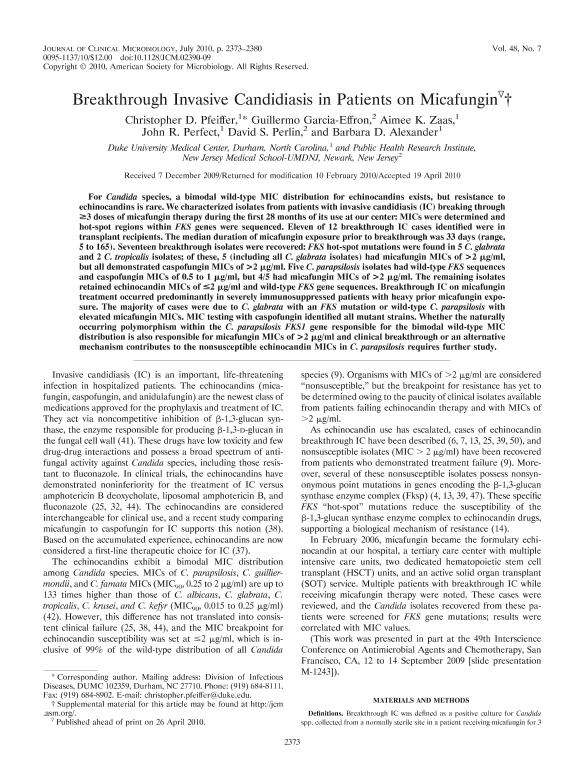Mostrar el registro sencillo del ítem
dc.contributor.author
Pfeiffer, Christopher D.
dc.contributor.author
Garcia, Guillermo Manuel

dc.contributor.author
Zaas, Aimee K.
dc.contributor.author
Perfect, John R.
dc.contributor.author
Perlin, David S.
dc.contributor.author
Alexander, Barbara D.
dc.date.available
2020-03-20T16:23:40Z
dc.date.issued
2010-07
dc.identifier.citation
Pfeiffer, Christopher D.; Garcia, Guillermo Manuel; Zaas, Aimee K.; Perfect, John R.; Perlin, David S.; et al.; Breakthrough Invasive Candidiasis in Patients on Micafungin; American Society for Microbiology; Journal of Clinical Microbiology; 48; 7; 7-2010; 2373-2380
dc.identifier.issn
0095-1137
dc.identifier.uri
http://hdl.handle.net/11336/100414
dc.description.abstract
For Candida species, a bimodal wild-type MIC distribution for echinocandins exists, but resistance to echinocandins is rare. We characterized isolates from patients with invasive candidiasis (IC) breaking through ≥3 doses of micafungin therapy during the first 28 months of its use at our center: MICs were determined and hot-spot regions within FKS genes were sequenced. Eleven of 12 breakthrough IC cases identified were in transplant recipients. The median duration of micafungin exposure prior to breakthrough was 33 days (range, 5 to 165). Seventeen breakthrough isolates were recovered: FKS hot-spot mutations were found in 5 C. glabrata and 2 C. tropicalis isolates; of these, 5 (including all C. glabrata isolates) had micafungin MICs of >2 μg/ml, but all demonstrated caspofungin MICs of >2 μg/ml. Five C. parapsilosis isolates had wild-type FKS sequences and caspofungin MICs of 0.5 to 1 μg/ml, but 4/5 had micafungin MICs of >2 μg/ml. The remaining isolates retained echinocandin MICs of ≤2 μg/ml and wild-type FKS gene sequences. Breakthrough IC on micafungin treatment occurred predominantly in severely immunosuppressed patients with heavy prior micafungin exposure. The majority of cases were due to C. glabrata with an FKS mutation or wild-type C. parapsilosis with elevated micafungin MICs. MIC testing with caspofungin identified all mutant strains. Whether the naturally occurring polymorphism within the C. parapsilosis FKS1 gene responsible for the bimodal wild-type MIC distribution is also responsible for micafungin MICs of >2 μg/ml and clinical breakthrough or an alternative mechanism contributes to the nonsusceptible echinocandin MICs in C. parapsilosis requires further study.
dc.format
application/pdf
dc.language.iso
eng
dc.publisher
American Society for Microbiology

dc.rights
info:eu-repo/semantics/openAccess
dc.rights.uri
https://creativecommons.org/licenses/by-nc-sa/2.5/ar/
dc.subject
Echinocandinas
dc.subject
Resistencia
dc.subject
Candida
dc.subject
micafungina
dc.subject.classification
Enfermedades Infecciosas

dc.subject.classification
Ciencias de la Salud

dc.subject.classification
CIENCIAS MÉDICAS Y DE LA SALUD

dc.title
Breakthrough Invasive Candidiasis in Patients on Micafungin
dc.type
info:eu-repo/semantics/article
dc.type
info:ar-repo/semantics/artículo
dc.type
info:eu-repo/semantics/publishedVersion
dc.date.updated
2020-02-13T19:00:06Z
dc.journal.volume
48
dc.journal.number
7
dc.journal.pagination
2373-2380
dc.journal.pais
Estados Unidos

dc.journal.ciudad
Washington DC
dc.description.fil
Fil: Pfeiffer, Christopher D.. University of Duke; Estados Unidos
dc.description.fil
Fil: Garcia, Guillermo Manuel. Consejo Nacional de Investigaciones Científicas y Técnicas. Centro Científico Tecnológico Conicet - Santa Fe; Argentina. State University of New Jersey; Estados Unidos
dc.description.fil
Fil: Zaas, Aimee K.. University of Duke; Estados Unidos
dc.description.fil
Fil: Perfect, John R.. University of Duke; Estados Unidos
dc.description.fil
Fil: Perlin, David S.. State University of New Jersey; Estados Unidos
dc.description.fil
Fil: Alexander, Barbara D.. University of Duke; Estados Unidos
dc.journal.title
Journal of Clinical Microbiology

dc.relation.alternativeid
info:eu-repo/semantics/altIdentifier/doi/http://dx.doi.org/10.1128/JCM.02390-09
dc.relation.alternativeid
info:eu-repo/semantics/altIdentifier/url/https://jcm.asm.org/content/48/7/2373.long
dc.relation.alternativeid
info:eu-repo/semantics/altIdentifier/url/https://www.ncbi.nlm.nih.gov/pmc/articles/PMC2897493/
Archivos asociados
